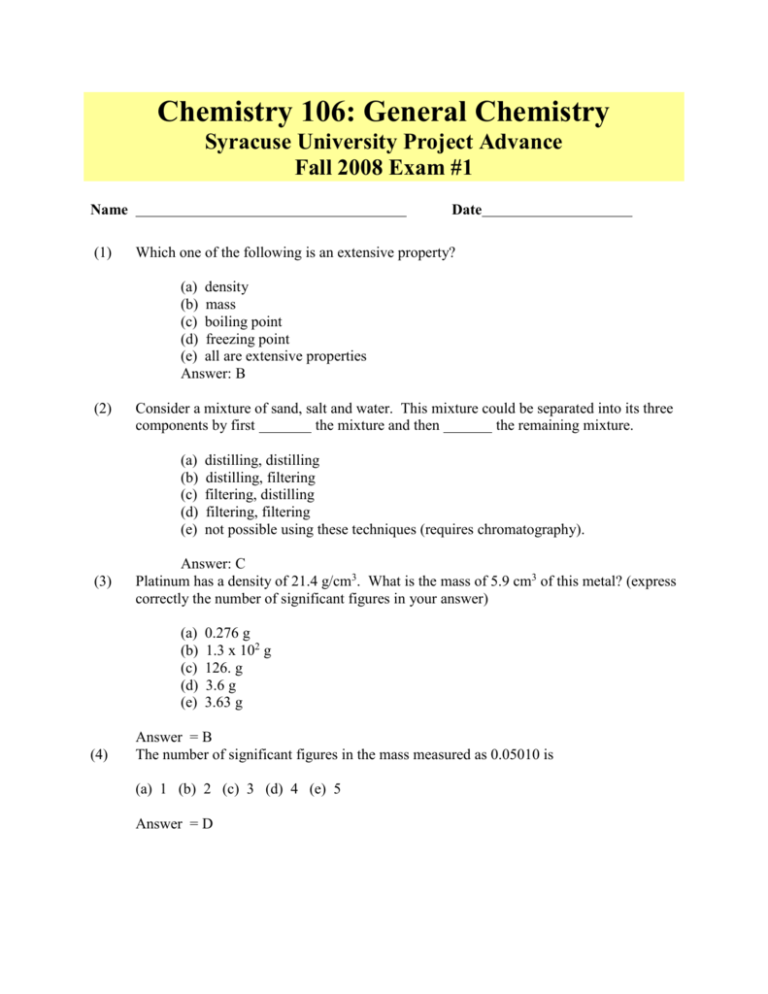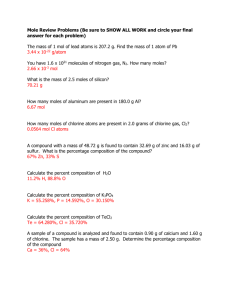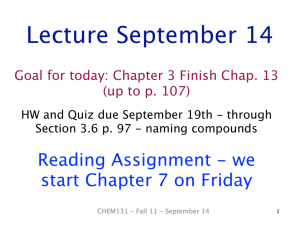chapter 1 - Revsworld
advertisement

Chemistry 106: General Chemistry Syracuse University Project Advance Fall 2008 Exam #1 Name (1) Date Which one of the following is an extensive property? (a) density (b) mass (c) boiling point (d) freezing point (e) all are extensive properties Answer: B (2) Consider a mixture of sand, salt and water. This mixture could be separated into its three components by first the mixture and then the remaining mixture. (a) (b) (c) (d) (e) (3) Answer: C Platinum has a density of 21.4 g/cm3. What is the mass of 5.9 cm3 of this metal? (express correctly the number of significant figures in your answer) (a) (b) (c) (d) (e) (4) distilling, distilling distilling, filtering filtering, distilling filtering, filtering not possible using these techniques (requires chromatography). 0.276 g 1.3 x 102 g 126. g 3.6 g 3.63 g Answer = B The number of significant figures in the mass measured as 0.05010 is (a) 1 (b) 2 (c) 3 (d) 4 (e) 5 Answer = D (5) A solution is a a) pure mixture b) heterogeneous mixture c.) pure element d) homogeneous mixture e) pure compound Answer = D (6) The melting point and the normal boiling point of water can be used to calibrate thermometers. What are these respective temperatures in Kelvin degrees? a) b) c.) d) e) 32 and 212 0 and 100 100 and 273 0 and 373 273 and 373 Answer = E (7) Which of the statements I-V is (are) correct? I. II. III. IV. V. (a) (b) (c) (d) (e) (8) Barium Nitrate is Ba(NO3)2 Calcium carbonate is CaCO3 Sodium perchlorate is NaClO4 Lithium carbonate is Li2CO3 KNO3 is potassium nitrate all are correct all except IV II and IV only I, II, and III only none is correct Answer: A The species 11H, 21H and 31H represent three (a) (b) (c) (d) (e) allotropes homologs isomers isotopes members of an homologous series Answer: D (9) A sodium ion differs from a sodium atom in that the sodium ion (a) (b) (c) (d) (e) (10) is more reactive has fewer electrons is an isotope of sodium exists only in solution has a negative charge on the nucleus Answer: B When alpha particles were shot at a gold target, most of the particles were undeflected. This indicated to Rutherford that (a) the gold foil was continuous matter (b) the mass of the gold atoms was spread out thinly and the electron carried the negative charge (c) the atoms of gold were mostly empty space (d) the alpha particles had great penetrating power and the nucleus has a positive charge (e) the alpha particles had charges opposite to those on the gold nuclei Answer: C (11) (12) and reside in the atomic nucleus (a) protons, electrons (b) protons, neutrons (c) neutrons, electrons (d) none of these Answer = B Which one of the following formulas is also an empirical formula? (a) C6H6O2 (b) C2H6SO (c) H2O2 (d) H2P4O6 (e) C6H6 Answer = B (13) Magnesium reacts with a certain element to form a compound with the general formula MgX. What would be the most likely formula for the compound formed between potassium and element X? (a) K2X (b) KX2 (c) K2X3 (d) K2X2 (e) potassium and X cannot form a compound Answer = A (14) The species formed when a neutral atom loses an electron is called (a) an anion. (b) a cation. (c) an isotope. (d) a charge mass ratio. (e) an isomer. Answer = B (15) What is the sum of the coefficients for the following chemical reaction when it is balanced? ____ Al + ____ Fe3O4 ____ Al2O3 + ____ Fe a. b. c. d. e. 9 16 17 24 none of the above Answer = D (16) The composition of oxalic acid is 26.7% carbon, 2.2% hydrogen and 71.1% oxygen, by mass. What is the empirical formula of oxalic acid? A b. c. d. e. CHO2 CHO C2HO4 C2HO2 none of the above Answer = A (17) Which combination represents a a) b) c.) d) e) 57p, 26n, 54e 26p, 31n, 29e 26p, 31m, 26e 57p, 26n, 23e 26p, 31n, 23e Answer = E 57 26 Fe 3+ ion? (18) A certain element has two naturally occurring isotopes. These isotopes have mass numbers of 63 and 65, and their fractional abundances are, respectively, 0.692 (69.2%) and 0.308 (30.8%). What is the atomic weight (or atomic mass) of this element? a) b) c.) d) e) 58.7 63.1 63.6 64.4 65.4 Answer = C (19) According to the following balanced reaction, how many moles of manganese(II) chloride can be produced when 1.83 g of HCl gas completely reacts with manganese(IV) oxide? MnO2(s) + 4 HCl(aq) ------> Cl2(g) + MnCl2(g) + 2H2O(l) (a) (b) (c) (d) (e) (20) 0.0125 moles 1.577 moles 0.010 moles 0.00313 moles none of these Answer: A When the reaction below is correctly balanced, the coefficients are NH3 + O2 ------> NO2 + H2O (a) (b) (c) (d) (e) 1,1,1,1 4,7,4,6 2,3,2,3 1,3,1,2 none of these Answer: B (21) How many aluminum atoms are there in 25 g of Al2S3? (a) (b) (c) (d) (e) 1.0 x 1023 2.0 x 1023 4.5 x 1023 4.0 x 1021 6.0 x 1021 Answer = B (22) What is the percentage of mass of oxygen in vanillin, C8H8O3, which is used as a flavoring? (a) (b) (c) (d) (e) 27.3% 31.6% 45.8% 63.2% 68.4% Answer = B Questions (23) and (24). Consider the following reaction: 4KO2(s) + 2H2O(l) 4KOH(s) + 3O2(g) The reaction vessel initially contains 0.25 mol KO2 and 0.15 mol H2O. (23) Which is the limiting reactant? a) b) c) d) e) KO2 H2O KOH O2 cannot be determined from the given data Answer = A (24) How many moles of O2 can be produced? a) b) c) d) e) 0.22 mol 0.19 mol 0.25 mol 0.15 mol 0.39 mol Answer = B (25) A compound has an empirical formula of CH2 and a molecular weight of 56.06 amu. Calculate the molecular formula of the compound: a) b) c.) d) e) CH2 C3H6 C2H4 C5H10 C4H8 Answer = E (26) What is the molarity of sodium hydroxide (NaOH, molar mass = 40.01 g) solution made by dissolving 57.2 g of NaOH in 250 mL of water? (a) (b) (c) (d) (e) 0.1092 M 2.80 M 14.3 M 6.99 M 5.72 M Answer: E (27) When a 25.0 mL sample of HNO3(aq) was titrated with 0.101 M NaOH(aq), the stoichiometric point was reached when 41.2 mL of the base had been added. What is the concentration of HNO3(aq) in the sample? (a) (b) (c) (d) (e) 0.166 M 0.00416 M 0.104 M 0.101 M 0.332 M Answer: A (28) The balanced net ionic equation for the precipitation of CaCO3 when aqueous solutions of Li2CO3 and CaCl2 are mixed is (a) (b) (c) (d) (e) 2 Li+(aq) + CO32-(aq) ------> Li2CO3(aq) 2 Li+(aq) + 2 Cl-(aq) ------> 2 LiCl(aq) Li+(aq) + Cl-(aq) ------> LiCl(aq) Ca2+(aq) + CO32-(aq) ------> CaCO3(s) Li2CO3(aq) + CaCl2(aq) ------> 2 LiCl(aq) + CaCO3(s) Answer: D (29) What are the respective molar concentrations of Na+ and SO42- afforded by dissolving 0.500 moles of Na2SO4 in water and diluting it to 1.33 L? (a) (b) (c) (d) (e) 0.665 and 0.665 0.665 and 1.33 1.33 and 0.665 3.76 and 7.52 0.752 and 0.376 Answer: E (30) What is the oxidation number of Mn in KMnO4? (a) (b) (c) (d) (e) -3 0 +3 +7 +5 Answer =D EC) The combustion of 3.42 g of a compound known to contain only nitrogen and hydrogen was burned in oxygen. The result was the formation of 9.82 g of NO2 and 3.85 g of water. Determine the empirical formula of this compound. SHOW ALL WORK (a) (b) (c) (d) (e) NH NH2 N2H NH3 N2H4 Answer: B






